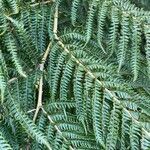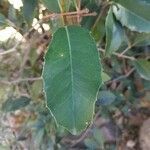Evergreen shrub, or more usually a tree, 4-24(-40) m tall and up to 0.3(-1) m in diameter at the base of the trunk; bark grey, fairly smooth; young branchlets often puberulous. Leaves alternate; lamina dark green above, paler beneath, elliptic, oblong-elliptic, obovate-elliptic, or elliptic-lanceolate, rarely almost round, 2.5-14 cm long, 1.3-4.6(-5.3) cm wide, acute, apiculate or rounded at the apex, obtuse to cuneate at the base, entire or sometimes spinous-toothed, particularly towards the apex, glabrous; midrib deeply impressed above; petiole 5-10 mm long; stipules subpersistent, ± 0.75-1 mm long. Cymes axillary, usually fascicled, rarely solitary, 1-6(-7)-flowered in [male]plants, 1-4(-5)-flowered in [female] plants; peduncles 1-15 mm long, puberulous; pedicels 3-8(-14) mm long; bracts and bracteoles minute. Flowers fragrant. Sepals 4-6(-8), rounded or subacute, ± 1.5 mm long and wide, joined at the base, ciliolate. Petals white, 4-6(-8), rounded or elliptic, ± 3.5 mm long and 1.5 mm wide, joined at the base. Male flowers with stamens 1.5-2 mm long; rudimentary ovary conical, grooved, beaked, slightly bilobed. Female flowers with shorter staminodes; ovary globose, 4-6(-8)-locular; stigma discoid, 4-6(-8)-lobed. Drupes yellow-green, turning brownish-violet or crimson when ripe, globose, 4-7 mm in diameter, rugulose and sometimes ribbed when dry, containing 4-6(-8) pyrenes. Seeds brownish, 2-3 mm long, 1 mm wide.
A medium to large tree. It grows 10-30 m high. The bark is very pale grey. The young branches are tinged with purple. The leaves are alternate and simple. They are narrowly oval and 7-13 cm long by 1.9-4.5 cm wide. They are shiny dark green. The side veins form loops. The young leaves are reddish. The flowers are white and 7 mm across. They have a sweet scent. They occur in clusters in the axils of leaves. They can be 3 cm long. The sexes are separate on separate trees. The fruit is berry-like and almost round. It is 7 mm across. It develops slowly but becomes bright red. The fruit are edible.
Leaf-lamina up to 13 × 4·5 cm., narrowly elliptic to lanceolate, apex acute, subrounded or emarginate and apiculate, obtuse to subacute at the base, entire or remotely denticulate (particularly towards the apex), glabrous, with numerous spreading looped lateral nerves; petiole c. 1 cm. long; stipules narrowly triangular, deciduous.
Flowers pedicellate, unisexual by abortion; male flowers (1)3–5(7), subumbellate with peduncles up to 1 cm. long; female flowers 1–3(5), subumbellate on shorter peduncles or subfasciculate.
Tree up to 20–30 m. high or shrub, sometimes straggling, with dark shining green foliage; bark light grey-brown with prominent whitish lenticels; dioecious.
Fruit of (4)5–6(7) pyrenes, c. 7 mm. in diam., subglobose, red, partially enclosed at the base by the persistent sepals.
Dioecious tree to 30 m. Leaves elliptic, glossy. Flowers in axillary clusters, white, fragrant.
Inflorescences axillary, solitary or congested.
Sepals minutely ciliolate.
Stigma thick and sessile.
Ovary (4)5–6(7)-locular.
A tree, to 40 ft. high
Flowers cream or white
Dark green foliage
Ripe fruits red
Petals whitish.



